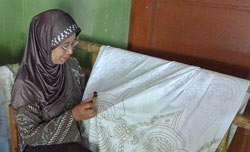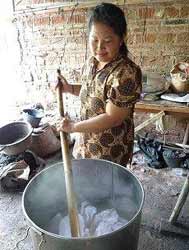
Against a backdrop of emerald palm leaves, Suminah Sukardi plunges multi-colored cloth into a steaming cauldron. Moments later she slaps the fabric down on concrete and squeezes out the water with her toes. It is the final step in the complex production of batik, a technique that uses wax to create elaborate designs on fabric.
Suminah showed the process to visitors during a recent tour led by the International Organization for Migration, which provides job training to 18 villages in Central Java. The tours highlight three traditional industries - silver working, batik dyeing and weaving.
Diana Setiawati with the IOM explains the objective of the tours, which began six months ago.
"One is promoting the village itself, and two we are trying to also open the mindset of the emencees [beneficiaries], we are assisting there," she said. "…They start to understand, if there is a Japanese tourist that comes here they would prefer to have this color and then European tourists come here and they prefer this color."
In addition to familiarizing craft workers with their buyers, the IOM helps them reach a larger market. So far the tours are the main way they can display and sell their work, but a restaurant in nearby Yogjakarta has started selling some products.
The village was among those devastated by a 2006 earthquake that destroyed homes and local industry.
For months after the disaster, cloth was hard to find. Batik-maker Daliyem says she could only afford low-quality material typically used to wrap bodies before burial. Despite a lack of experience, she tried selling the batik herself rather than going through a supplier, but sales were poor and she feared the market for batik was disappearing.
She says she wondered "Where are the buyers?". Whatever she made she still had at the end of the day and, she says, she wondered, do people want batik or not? That was a big question.

With training and support from the IOM, these women have improved the quality of their products. They say they benefit from using natural dyes, which makes their batik more environmentally friendly. UNESCO's recognition last year of batik as part of Indonesia's intangible cultural heritage has also improved its allure.
Daliyem says she is happy people are paying attention to her craft. She says her products can be more advanced now that she is skilled, and when people come to visit it can lift the craft up more. But, she says, the main thing she feels about her work now is pride.
The IOM chose the villages it is assisting based on their poverty level and the extent of earthquake damage they suffered. The villages produced handicrafts before the quake, but the IOM helped them develop their skills into a revenue earner.
Many of the women in Kebon worked as laborers and handed their products over to suppliers. Their pay was around $50 a month. With the IOM program they operate under a profit-sharing system.
Suminah, who is 56, has been making batik since she was a child. She says she can make as much as $150 a month as part of the cooperative, which has opened her eyes to a world outside Kebon. She says the cooperative increases her knowledge and her acquaintances. Her point of view is growing and so is her income.
The IOM's Setiawati says the women are ready to expand their business, but the big concern is how they will market their products without the IOM's assistance. The IOM program, which is paid for by earthquake recovery funds for Java, ends in May.
"For now it's like a honeymoon," she said. "People come and see their products and IOM facilitated them to go to an expo in Jakarta and they made like 10 million rupiah in four days ... but they also need to understand how they can allocate that for their own promotion activities."
To build long-term support for the crafts workers, the IOM is strengthening ties between these small industries and the government and is turning to companies that invest in corporate social responsibility. But Setiawati says more time is needed. The IOM has applied to the earthquake recovery organization to have its contract extended to July 2011.
At a recent World Bank forum in Washington, Setiawati spoke about how the lessons from the IOM's experience in Yogyakarta could be applied to other places, such as Haiti.
"Jogja actually has been seen as a successful model for a reconstruction program because the government is very open, the government is very assertive and they are very easily approachable to work with," she said. "The community here is also having a good motivation and spirit to rebuild their lives. They are not only focusing on receiving money, money, money, but they also understand that they have potential within themselves to rebuild their lives."
She says the products still need polishing to be of export quality, but the women are ambitious and continue to display their own designs with pride and energy.
cauldron: a large deep pot for boiling liquids or cooking food over a fire 大锅
batik: a method of printing patterns on fabric using wax on the parts that will not have any colour; a piece of fabric printed in this way 蜡防印花法;巴蒂克印花法;蜡防印花布
Quakes topple hundreds of houses
UN mobilizes huge relief operation in Indonesia
Relief operations move into high gear on Indonesia's Nias Island
(来源:VOA 编辑:陈丹妮)
